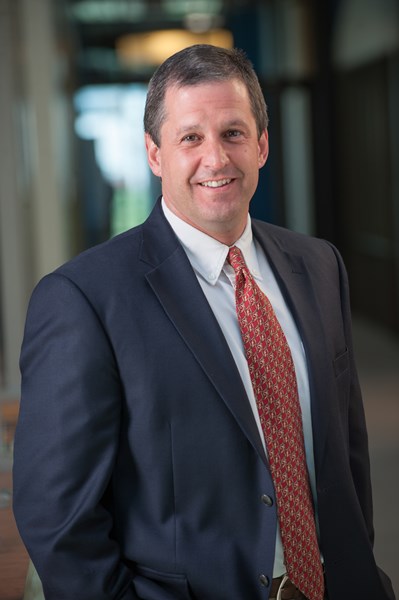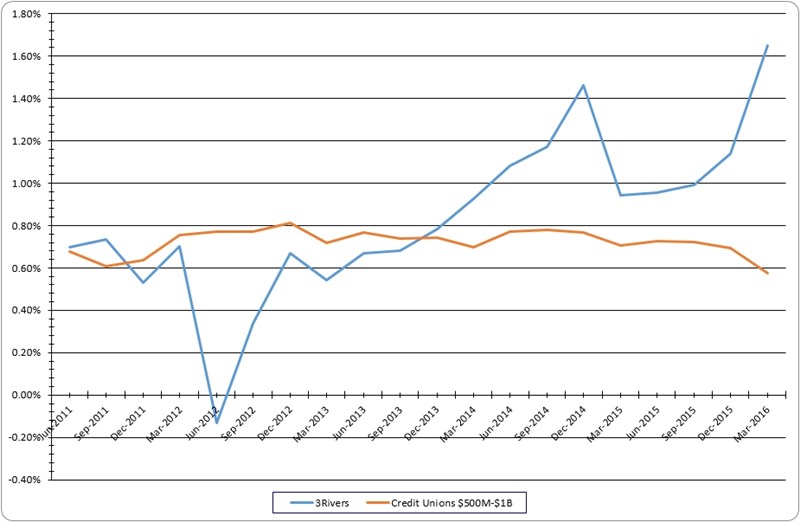The re-design of the headquarters of 3Rivers Federal Credit Union ($821.2M, Fort Wayne, IN) was already a concept in action when Don Cates arrived in October 2011 as executive vice president and chief operating officer. But as president and CEO one year later, he brought to fruition the idea to create a campus that conveys to employees the freedom to think and act differently.
The credit union’s new LEED Certified Silver facility combines state-of-the-art mechanical systems and glazing and shading systems to decrease heating and cooling needs while improving the comfort of building occupants.
But more important is the resulting cultural transformation that took place inside 3Rivers. Here, Cates talks renovation, open-office concepts, and more.
CU QUICK FACTS
3RIVERS FEDERAL CREDIT UNION
Data as of 03.31.16
- HQ: Fort Wayne, IN
- ASSETS: $821.2M
- MEMBERS: 70,848
- BRANCHES: 18
- 12-MO SHARE GROWTH: 3.6%
- 12-MO LOAN GROWTH: 7.5%
- ROA: 1.7%
When did 3Rivers complete the new headquarters? How long did it take, and how much did it cost?
Don Cates: We completed Northland East in November 2012 and Northland West in July 2013. We couldn’t remodel Northland West, our existing building, without significantly disrupting business, but we had the land that allowed us to build the new building and then renovate the existing one.
There was approximately six months of project planning followed by 18 months from groundbreaking to completion. The cost was $13.5 million for the headquarters buildings, but we also built three new branches and built out two others in rented space, so our total investment over 18 months was $19.7 million.
Why did you go with the open-office concept? How did you begin the process of executing on that vision?
DC: The concept was already in place when I came to the credit union. We saw the need to create spaces for greater collaboration among our team. We researched the functionality and efficiency of work environments in Silicon Valley, including Google, and we visited workspace design companies for ideas.
3Rivers Federal Credit Union used Momentum Inc. as its design-build partner. Find your next solution in the Callahan & Associates online Buyer’s Guide.
Please describe your new set up.
DC: The majority of team members are in 36-inch low-rise pods grouped by resource centers. The lead team members are all in open front stalls that look over their teams. The three executive offices are in the center of the building. They’re the only work spaces that don’t provide the ability to see outside, but they are glass and don’t have doors.
What changes did you make for tellers and other member-facing staff?
 |
| Don Cates, CEO, 3Rivers Federal Credit Union |
DC: We incorporated a new branch concept into all five new facilities. The branches have an open, concierge-style teller island, with the platform staff and management working out of a common workroom. There are two styles for meeting rooms for member service or business service. These rooms don’t have traditional desks. They have couches and floating tables so the interaction can be more conversational.
How did you introduce your staff to the new setup? How have they responded?
DC: The project team set up sample workspaces so staff could see what to expect. We had information sessions to answer questions and reinforced the principle of the space being conducive to collaboration over and over. When we moved into Northland East, approximately half the team moved in. The bestselling point to the others is they saw the ability to have greater ability to communicate.
People also have found their own ways to leverage the flexibility available to them. They can work in different locations around the campus or even at home, and you see a lot of earbuds in use. We also have IM, which you can put your status on as Do Not Disturb.
What did you do as CEO to help everyone, including yourself, adapt to the new culture?
DC: At first I sat in a cafarea a lot and worked from there, but now I’m mostly in there for lunch, as are many other people. The floor plan has improved my accessibility and that of all the lead team. People know they can pop in if they want to.
Why is such accessibility important?
DC: Isolationism via the workspace can’t help but foster the perception of being inaccessible, which creates a disconnection. Being able to walk by my desk without going through a gatekeeper, even just to say good morning or good night, is powerful. It puts us all on the same level.
We want to demonstrate our culture of openness, accessibility, coaching, freedom, empowerment, and mobility. These facilities do that.
Now that you’re a couple years into it, how do you think this office design has helped your operations?
DC: People create silos, real or perceived, and the workspace can accentuate that. Once everything is opened up, people see other areas working hard, working with one another, communicating, and having fun.
I love giving tours of our building, stopping in areas to talk about it, and having the guest say out loud they would love to work in this kind of environment. It makes whoever is near sit up a little straighter and feel that sense of pride and appreciation.
We were also able to have a fitness center, which has aided in our 78% participation in our wellness program. We also have a video production room and a recording studio on site that we use for our in-house ad agency.
RETURN ON ASSETS
For all U.S. credit unions | Data as of 03.31.16
Callahan & Associates | www.creditunions.com

Source: Peer-to-Peer Analytics by Callahan & Associates
3Rivers’ return-on-assets was the seventh highest nationally among the 237 credit unions in its peer asset group in the second quarter of 2016.
What is your ROI on your investment in facilities? How do you measure what you’ve accomplished here?
DC:It’s hard to quantify, but we’ve seen benefits. I think our ability to attract talent is much greater now, for instance. We are huge believers in our culture, and these facilities foster that culture.
To outperform you have to take away impediments to top performance, and buildings can be that, both HQ and branches. It’s hard to walk the talk if your environment doesn’t allow you to. We want to demonstrate our culture of openness, accessibility, coaching, freedom, empowerment, and mobility. These facilities do that.
We want to stretch as far as possible with our assets so they don’t limit our people they inspire them.
7 Ways Design Can Build Cultural Success
Don Cates, president and CEO of 3Rivers Federal Credit Union, shares tips to ensure success when redesigning office space to foster a new culture.
- Workspace should fit your culture, not limit it. Remember, the building isn’t your culture. It fosters your culture.
- Share the why behind it. Let everyone know the vision. It might not be the right environment for some, but that’s OK.
- It’s just space; no one owns it. If it is truly open, then it should be easy to move around and change folks around to improve collaboration, communication, and personal connectivity.
- The technology has to match the workspace. 3Rivers has roaming profiles so staff can work anywhere in the buildings. They also can forward their phone calls anywhere.
- Provide hotel space because other staffers will want to come and work out of this environment.
- Learn to communicate appropriately. It’s open, so understand what that means for others.
- Provide different interaction areas to meet and collaborate. Offer meeting rooms of various sizes and configurations that are schedulable and un-schedulable to allow for impromptu meetings. 3Rivers has more than 18 meeting rooms in addition to an outside courtyard and two cafs.
You Might Also Enjoy
-
Earnings By The Numbers
-
How A New HQ Tells This Credit Union’s Story A Different Way
-
Anatomy Of A Dual Market: Cash Management
-
5 Ways To Supercharge The Branch Experience